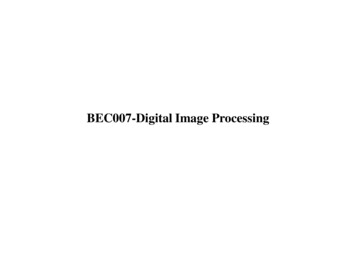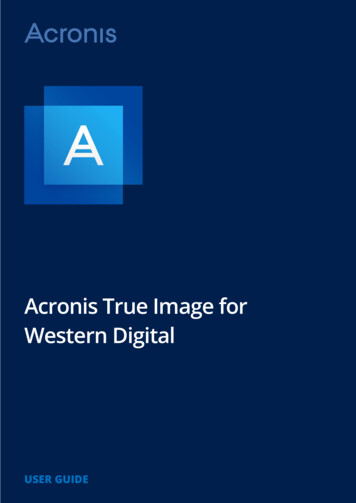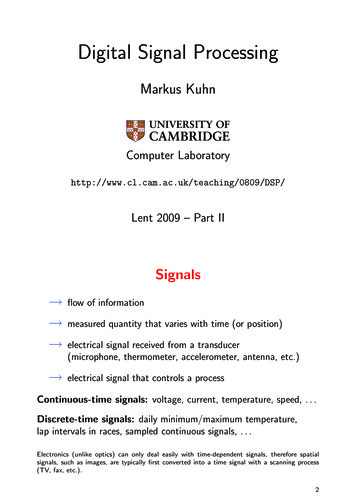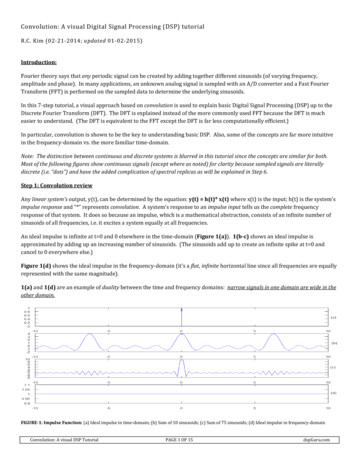
Transcription
BEC007-Digital Image Processing
UNIT IDIGITAL IMAGE FUNDAMENTAL Elements of digital image processing systemsElements of Visual perceptionImage sampling and quantizationMatrix and Singular Value representation of discreteimages.
What is a Digital Image? A digital image is a representation of a twodimensional image as a finite set of digital values, calledpicture elements or pixels
Cont. Pixel values typically represent gray levels, colours,heights, opacities etc Remember digitization implies that a digital image isan approximation of a real scene1 pixel
Cont.Common image formats include:1 sample per point (B&W or Grayscale)3 samples per point (Red, Green, and Blue)4 samples per point (Red, Green, Blue, and“Alpha”, a.k.a. Opacity)For most of this course we will focus on greyscale images
What is Digital Image Processing? Digital image processing focuses on two major tasks– Improvement of pictorial information for humaninterpretation– Processing of image data for storage, transmissionand representation for autonomous machineperception Some argument about where image processing endsand fields such as image analysis and computer visionstart
cont The continuum from image processing to computervision can be broken up into low-, mid- and highlevel processes
History of Digital Image Processing Early 1920s: One of the first applications of digitalimaging was in the newspaper industry– The Bartlane cable picturetransmission service– Images were transferred by submarine cablebetween London and New York– Pictures were coded for cable transfer andreconstructed at the receiving end on a telegraphprinter
History of DIP (cont ) Mid to late 1920s: Improvements to theBartlane system resulted in higher quality images– New reproductionprocesses basedon photographictechniques– Increased numberof tones inreproduced imagesImproveddigital imageEarly 15 tone digital image
History of DIP (cont ) 1960s: Improvements in computing technologyand the onset of the space race led to a surge ofwork in digital image processing– 1964: Computers used toimprove the quality ofimages of the moon takenby the Ranger 7 probe– Such techniques were usedin other space missionsincluding the Apollo landingsA picture of the moon taken bythe Ranger 7 probe minutesbefore landing
History of DIP (cont ) 1970s: Digital image processing begins to beused in medical applications– 1979: Sir Godfrey N.Hounsfield & Prof. Allan M.Cormack share the NobelPrize in medicine for theinvention of tomography,the technology behindComputerised AxialTomography (CAT) scansTypical head slice CAT image
History of DIP (cont ) 1980s - Today: The use of digital image processingtechniques has exploded and they are now used for allkinds of tasks in all kinds of areas– Image enhancement/restoration– Artistic effects– Medical visualisation– Industrial inspection– Law enforcement– Human computer interfaces
History of DIP (cont ) 1980s - Today: The use of digital image processingtechniques has exploded and they are now used for allkinds of tasks in all kinds of areas– Image enhancement/restoration– Artistic effects– Medical visualisation– Industrial inspection– Law enforcement– Human computer interfaces
Image Processing Fields Computer Graphics: The creation of images Image Processing: Enhancement or othermanipulation of the image Computer Vision: Analysis of the image content
Image Processing FieldsInput /OutputImageImageImageProcessingDescription ComputerGraphicsDescriptionComputerVisionAI
Sometimes, Image Processing is defined as “adiscipline in which both the input and output of aprocess are imagesBut, according to this classification, trivial tasksof computing the average intensity of an imagewould not be considered an image processingoperation
Computerized Processes Types Low-Level Processes:– Input and output are images– Tasks: Primitive operations, such as, imageprocessing to reduce noise, contrast enhancementand image sharpening
Computerized Processes Types Mid-Level Processes:– Inputs, generally, are images. Outputs areattributes extracted from those images (edges,contours, identity of individual objects)– Tasks: Segmentation (partitioning an image intoregions or objects) Description of those objects to reduce them to aform suitable for computer processing Classifications (recognition) of objects
Computerized Processes Types High-Level Processes:– Image analysis and computer vision
Digital Image Definition An image can be defined as a two-dimensionalfunction f(x,y) x,y: Spatial coordinate F: the amplitude of any pair of coordinate x,y, whichis called the intensity or gray level of the image atthat point. X,y and f, are all finite and discrete quantities.
Fundamental Steps in Digital Image Processing:Colour ImageProcessingWavelets torationImageEnhancementImageAcquisitionProblem DomainMorphologicalProcessingSegmentationKnowledge BaseRepresentation& DescriptionObjectRecognitionOutputs of these processes generally are image attributesOutputs of these processes generally are images
Fundamental Steps in DIP: (Description)Step 1: Image AcquisitionThe image is captured by a sensor (eg. Camera), anddigitized if the output of the camera or sensor is notalready in digital form, using analogue-to-digitalconvertor
Fundamental Steps in DIP: (Description)Step 2: Image EnhancementThe process of manipulating an image so that theresult is more suitable than the original for specificapplications.The idea behind enhancement techniques is to bringout details that are hidden, or simple to highlightcertain features of interest in an image.
Fundamental Steps in DIP: (Description)Step 3: Image Restoration- Improving the appearance of an image- Tend to be mathematical or probabilistic models.Enhancement, on the other hand, is based on humansubjective preferences regarding what constitutes a“good” enhancement result.
Fundamental Steps in DIP: (Description)Step 4: Colour Image ProcessingUse the colour of the image to extract features ofinterest in an image
Fundamental Steps in DIP: (Description)Step 5: WaveletsAre the foundation of representing images in variousdegrees of resolution. It is used for image datacompression.
Fundamental Steps in DIP: (Description)Step 6: CompressionTechniques for reducing the storage required to savean image or the bandwidth required to transmit it.
Fundamental Steps in DIP: (Description)Step 7: Morphological ProcessingTools for extracting image components that are usefulin the representation and description of shape.In this step, there would be a transition fromprocesses that output images, to processes that outputimage attributes.
Fundamental Steps in DIP: (Description)Step 8: Image SegmentationSegmentation procedures partition an image into itsconstituent parts or objects.Important Tip: The more accurate thesegmentation, the more likely recognition is tosucceed.
Fundamental Steps in DIP: (Description)Step 9: Representation and Description- Representation: Make a decision whether the datashould be represented as a boundary or as a completeregion. It is almost always follows the output of asegmentation stage.- Boundary Representation: Focus on externalshape characteristics, such as corners andinflections ( )اﻧﺤﻨﺎءات - Region Representation: Focus on internalproperties, such as texture or skeleton ( )ھﯿﻜﻠﯿﺔ shape
Fundamental Steps in DIP: (Description)Step 9: Representation and Description- Choosing a representation is only part of the solutionfor transforming raw data into a form suitable forsubsequent computer processing (mainly recognition)- Description: also called, feature selection, deals withextracting attributes that result in some information ofinterest.
Fundamental Steps in DIP: (Description)Step 9: Recognition and InterpretationRecognition: the process that assigns label to anobject based on the information provided by itsdescription.
Fundamental Steps in DIP: (Description)Step 10: Knowledge BaseKnowledge about a problem domain is coded into animage processing system in the form of a knowledgedatabase.
Components of an Image Processing SystemNetworkImage displaysComputerMass storageHardcopySpecialized imageprocessing hardwareImage processingsoftwareProblem DomainImage sensorsTypical generalpurpose DIPsystem
Components of an Image Processing System1. Image SensorsTwo elements are required to acquire digital images.The first is the physical device that is sensitive to theenergy radiated by the object we wish to image(Sensor). The second, called a digitizer, is a devicefor converting the output of the physical sensingdevice into digital form.
Components of an Image Processing System2. Specialized Image Processing HardwareUsually consists of the digitizer, mentioned before,plus hardware that performs other primitiveoperations, such as an arithmetic logic unit (ALU),which performs arithmetic and logical operations inparallel on entire images.This type of hardware sometimes is called a frontend subsystem, and its most distinguishingcharacteristic is speed. In other words, this unitperforms functions that require fast data throughputsthat the typical main computer cannot handle.
Components of an Image Processing System3. ComputerThe computer in an image processing system is ageneral-purpose computer and can range from a PCto a supercomputer. In dedicated applications,sometimes specially designed computers are used toachieve a required level of performance.
Components of an Image Processing System4. Image Processing SoftwareSoftware for image processing consists ofspecialized modules that perform specific tasks. Awell-designed package also includes the capabilityfor the user to write code that, as a minimum,utilizes the specialized modules.
Components of an Image Processing System5. Mass Storage CapabilityMass storage capability is a must in a imageprocessing applications. And image of sized 1024 *1024 pixels requires one megabyte of storage spaceif the image is not compressed.Digital storage for image processing applicationsfalls into three principal categories:1. Short-term storage for use during processing.2. on line storage for relatively fast recall3. Archival storage, characterized by infrequentaccess
Components of an Image Processing System5. Mass Storage CapabilityOne method of providing short-term storage iscomputer memory. Another is by specialized boards,called frame buffers, that store one or more imagesand can be accessed rapidly.The on-line storage method, allows virtuallyinstantaneous image zoom, as well as scroll (verticalshifts) and pan (horizontal shifts). On-line storagegenerally takes the form of magnetic disks andoptical-media storage. The key factor characterizingon-line storage is frequent access to the stored data.
Components of an Image Processing System6. Image DisplaysThe displays in use today are mainly color(preferably flat screen) TV monitors. Monitors aredriven by the outputs of the image and graphicsdisplay cards that are an integral part of a computersystem.
Components of an Image Processing System7. Hardcopy devicesUsed for recording images, include laser printers,film cameras, heat-sensitive devices, inkjet units anddigital units, such as optical and CD-Rom disks.
Components of an Image Processing System8. NetworkingIs almost a default function in any computer system,in use today. Because of the large amount of datainherent in image processing applications the keyconsideration in image transmission is bandwidth.In dedicated networks, this typically is not aproblem, but communications with remote sites viathe internet are not always as efficient.
Elements of Visual perceptionStructure of the human eye The cornea and sclera outer cover The choroid– Ciliary body– Iris diaphragm– Lens The retina– Cones vision (photopic/bright-light vision):centered at fovea, highly sensitive to color– Rods (scotopic/dim-light vision): general view– Blind spot44
Human eye45
Cones vs. Rods
Hexagonal pixelCone distribution on thefovea (200,000 cones/mm2) Models human visual system more precisely The distance between a given pixel and itsimmediate neighbors is the same Hexagonal sampling requires 13% fewersamples than rectangular sampling ANN can be trained with less errors
More on the conemosaicThe cone mosaic of fish retinaLythgoe, Ecology of Vision (1979)Human retina mosaicThe mosaic array of most-Irregularity reduces visualvertebrates is regularacuity for high-frequency signals-Introduce random noise
A mosaicked multispectral camera
Brightness adaptation Dynamic range ofhuman visual system– 10-6 104 Cannot accomplish thisrange simultaneously The current sensitivitylevel of the visualsystem is called thebrightness adaptationlevel50
Brightness discrimination Weber ratio (the experiment) DIc/I––––I: the background illuminationDIc : the increment of illuminationSmall Weber ratio indicates good discriminationLarger Weber ratio indicates poor discrimination
Psychovisual effects The perceivedbrightness is not asimple function ofintensity– Mach band pattern– Simultaneouscontrast52
Image formation in the eye Flexible lens Controlled by the tension in the fibers of theciliary body– To focus on distant objects?– To focus on objects near eye?– Near-sighted and far-sighted
Image formation in the eyeBrainLight receptorradiantenergyelectricalimpulses
A simple image formation model f(x,y): the intensity is called the gray level formonochrome image f(x, y) i(x, y).r(x, y)– 0 i(x, y) inf, the illumination (lm/m2)– 0 r(x, y) 1, the reflectance Some illumination figures (lm/m2)– 90,000: full sun- 0.01: blackvelvet– 10,000: cloudy day- 0.93: snow– 0.1: full moon– 1,000: commercial office
Camera exposure ISO number– Sensitivity of the film or the
Digital image processing focuses on two major tasks – Improvement of pictorial information for human interpretation – Processing of image data for storage, transmission and representation for autonomous machine perception Some argument about where image processing ends and fields such as image analysis and computer vision start











